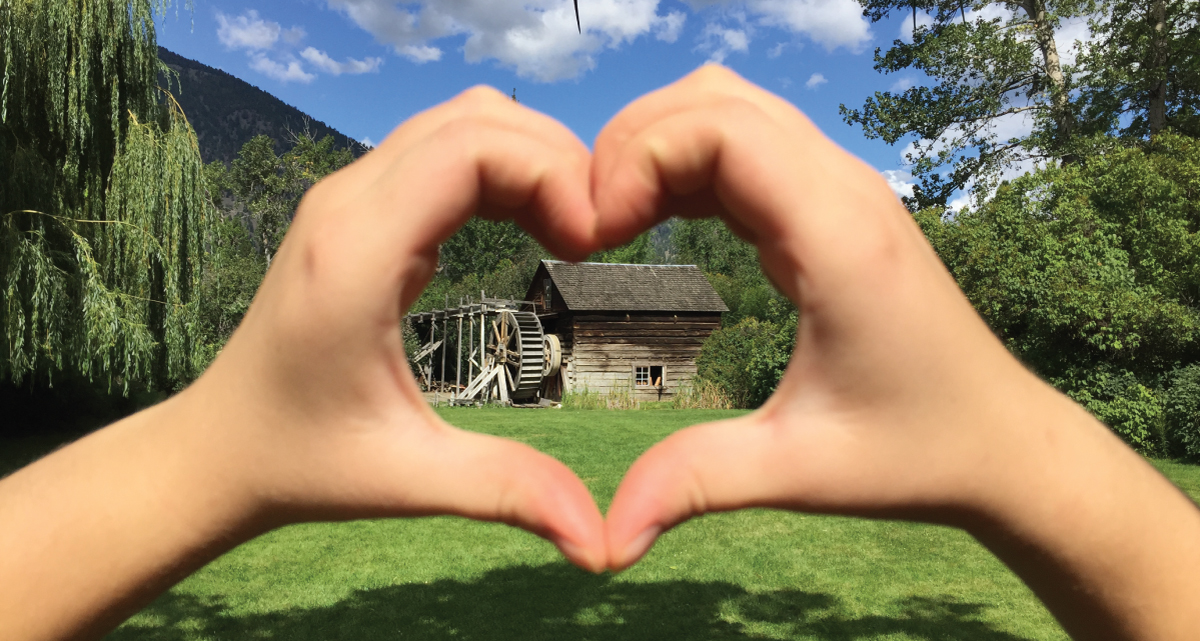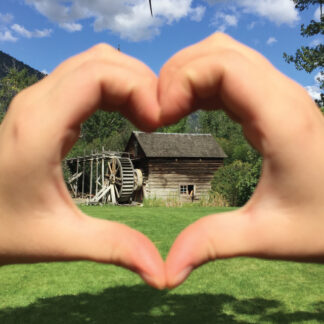Description
For nearly 150 years, the Grist Mill and Gardens has overlooked the spectacular Similkameen Valley, bearing witness to countless changes in the land, people, and traditions. From the Indigenous presence and early settlement patterns that shaped its early history, to the Mill’s own evolution through periods of growth, decline, and careful restoration, its story forms a vital chapter in British Columbia’s cultural tapestry.
As we approach the 40th anniversary of the Grist Mill’s public opening as a heritage site, we’re hoping to create a richly detailed history book of this special place over the last 150+ years.
Supported by the legendary Cuyler Page—founding general manager and a key figure in the Mill’s transformation over the last four decades—our team will combine archival research, community stories, archival images and more to create a one-of-a-kind chronicle of this special place and it’s place in a broader context. Your early contribution will help us fund the essential groundwork: the research, writing, and securing of image rights that will form this special book’s foundation.
Why Now?
With Cuyler in his mid-80s, this is our chance to record and preserve his unmatched knowledge. Your backing at this stage safeguards the unique insights he’s gathered over a lifetime. By helping now, you ensure that the stories, images, and historical nuances of the Grist Mill endure—and as a bonus, you’ll have the opportunity to purchase the completed book at cost once it’s published.
- January:
- Gather, review, and organize existing documents and research materials.
- Confirm image permissions and begin interviews with Cuyler and other key contributors.
- February – March:
- Complete initial writing of early chapters, focusing on pre-settlement context, Indigenous communities, and the establishment of the Mill.
- Continue archival deep-dives, refine research leads, and select key images for inclusion.
- April – May:
- Revise and refine manuscript drafts with editorial input.
- Begin initial layout discussions, integrating images, captions, and timelines.
- June – July:
- Finalize the manuscript and design elements, preparing materials for the publication stage.
- Confirm printing and distribution plans.
By late summer, we aim to have a finalized manuscript ready to move into production. At that point, contributors who supported this initial phase can purchase the finished book at cost.
Contributing to this fundraising campaign entitles you to certain benefits, depending on your contribution level.
Entry-Level Contributions ($25 – $50)
$25: $50:
Mid-Level Contributions ($100 – $250)
| $100: |
|
| $250: |
|
Higher-Level Contributions ($500 – $1,000)
| $500: |
|
| $1,000: |
|
Major Benefactor Contributions ($2,500 and Above)
| $2,500: |
|
| $5,000 or More: |
|
Working Title: “The Grist Mill and Gardens at Keremeos: A History of Community, Innovation, and Preservation”
Introduction
- Overview of the Site’s Importance: A brief introduction to the Grist Mill and Gardens as a heritage site, highlighting its relevance to local history, agriculture, and community life.
- Personal Introduction: Cuyler’s personal connection to the site and his reasons for being involved with this book.
Part 1: Pre-Settlement Context
- Indigenous History of the Similkameen Valley: Overview of indigenous communities, their relationship with the land, and cultural practices relevant to the area around the Grist Mill.
- Early Settlement Patterns: Trends in exploration, fur trading, and settlement that set the stage for later developments in the region.
Part 2: Establishment of the Grist Mill
- The Need for the Mill: Social and agricultural needs that led to the construction of the Grist Mill in the late 1870s.
- Construction and Early Years (1877): Details about the original building, machinery, and the first miller. Contextualize the Mill’s early role in the community.
- Successive Owners and Uses: Chart the Mill’s evolution through the years, its changing ownership, and shifts in its purpose (grinding grain, bunk house, art studio, storage, disuse).
Part 3: Decline and Abandonment
- The Mill’s Decline: Explore the broader economic and agricultural changes that led to the Mill’s disuse and eventual abandonment.
- Local Memories and Lore: Any local stories or legends about the Mill during this period of neglect.
Part 4: From Disused to Heritage Site
- Government Acquisition (1970/80s): The movement to preserve the Mill, its purchase by the provincial government, and the decision to restore it as a heritage site.
- Restoration and Exhibit Development: Detailed accounts of the restoration process, highlighting the technical, historical, and interpretive challenges.
- Cuyler’s Role in the Restoration: Cuyler’s involvement in key decisions, including the design of exhibits, preservation of the site’s authenticity, and development of programming.
- Opening to the Public (1985): Reflections on the ribbon-cutting and the public’s reaction to the site becoming a cultural landmark.
Part 5: The Grist Mill’s Modern Institutional History
- The Mill’s Role in the Local Community: How the Mill has been integrated into the life of the Similkameen Valley over the past 40 years. Focus on events, educational programming, and community engagement.
- Changing Operators and Management Styles: An exploration of the different operators who have managed the Mill over the decades and how each left their mark.
- Challenges and Triumphs: The struggles (financial, logistical) and successes (awards, recognition) the Mill has faced during its 40 years as a public heritage site.
Part 6: Looking Forward
- Future Prospects: What’s next for the Grist Mill and Gardens? Discuss future plans for preservation, its role in the community, and how it might evolve.
- Upcoming 150th Anniversary: Set the stage for the Grist Mill’s 150th anniversary (2027), with a call for continued community involvement and support.
Conclusion
- Reflections from Cuyler: A personal note from Cuyler, reflecting on his decades of work at the Mill and the lasting legacy of the site.
- Invitation to Readers: An invitation for readers to visit the Grist Mill and Gardens and engage with its history.
Appendices
- Timeline of Major Events: A timeline that highlights key milestones in the Grist Mill’s history.
- References and Sources: A list of sources used in the writing of the book, acknowledging the research done over the years.
- Acknowledgments: Thanks to those who have supported the Grist Mill’s preservation and the writing of this book.
Check back soon for a list of the amazing folks helping to make this project happen!
Bringing a book like this to life is an exciting journey, but it’s also one that involves a few unknowns. Just as with restoring historic buildings or uncovering long-forgotten stories, creating a detailed history book can be full of surprises. Sometimes we stumble upon a new document that changes our understanding of an event, or we need extra time to track down a high-quality image from a distant archive. That’s all part of what makes this process so rewarding—but it also means we need to be flexible, patient, and ready to adapt.
Here are a few things we’re keeping in mind as we move forward:
- Finding the Perfect Sources:
Some materials we’d love to include—historic photographs, letters, or records—might not be easy to find or may require special permissions. Tracking them down and getting permission can take time, but it’s worth it to ensure the book tells the richest story possible. - Refining the Story:
As we dig deeper, we may uncover new information that inspires us to rewrite certain sections. This may mean more rounds of editing, but our goal is to make the book as accurate, engaging, and meaningful as possible. - Balancing Busy Schedules:
Our team members, including Cuyler, bring tremendous experience and knowledge to this project. Sometimes life’s commitments, health, or unexpected events can cause slowdowns. We’ll be mindful of everyone’s well-being and availability. - Production Ups and Downs:
When it comes time to print and distribute the book, external factors—like print shop turnaround times or shipping delays—might shift our anticipated release date. We’re prepared to pivot if needed and will keep you updated every step of the way.
Throughout this process, we promise to stay transparent. If we encounter delays or need to adjust our timeline, we’ll let you know. Your support and understanding are what make this project possible, and we’re grateful that you’re joining us for this adventure.


